|
Agni (Fire)
The Agni missiles have been designed and developed for delivery of nuclear munitions. The Agni-I is an intermediate range, rail-/road-mobile, single-stage, solid-motor, 700-800km-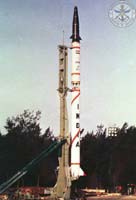 range/1,000kg-payload variant of the Agni family of ballistic missiles. Between January 2002 and June 2004 the version has been successfully tested thrice and declared ready for induction. range/1,000kg-payload variant of the Agni family of ballistic missiles. Between January 2002 and June 2004 the version has been successfully tested thrice and declared ready for induction. The Agni-II is a rail-/road-mobile, two-stage, all solid-fueled, 2,000-2,500km-range/1,000kg-payload missile that has undergone three successful developmental tests between April 1999 and August 2004 and has been ready for induction. Both the Agni-I and Agni-II versions have been handed over to the Indian Army, which has raised two new missile groups. The Agni-III, a 3,000-4,000 km-range variant, was successfully tested in April 2007 and May 2008. It may be ready for induction in 2009, probably after another flight test. 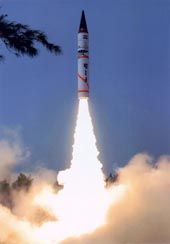 Yet to be determined is another variant, to be dubbed ether the Agni-IV or V, which will extend the range of this missile to 5,000km and above. Scientists have said that this version would involve adding a third stage to the Agni-III. Yet to be determined is another variant, to be dubbed ether the Agni-IV or V, which will extend the range of this missile to 5,000km and above. Scientists have said that this version would involve adding a third stage to the Agni-III.
This version would provide a true ICBM capability targeting north-east China, and cities like Beijing. Tactical missiles
BrahMos (Brahmaputra-Moskva)
 The impressive accretion in India's missile arsenal has undoubtedly been the unique supersonic cruise missile BrahMos. This Indo-Russian joint venture product represents a quantum jump in India's missile-building technological capabilities and, given its operational flexibility, has also become a key component of the country's missile forces. The impressive accretion in India's missile arsenal has undoubtedly been the unique supersonic cruise missile BrahMos. This Indo-Russian joint venture product represents a quantum jump in India's missile-building technological capabilities and, given its operational flexibility, has also become a key component of the country's missile forces. The BrahMos is a 280-300km-range/200-300kg-payload, 2.8 mach supersonic cruise missile derived from a Russian anti-ship missile, the Yakhont. It is a multi-platform, multi-objective cruise missile that has been successfully configured for ship-to-ship, ship-to-shore, land-to-land, land-to-ship (coastal defence) modes. 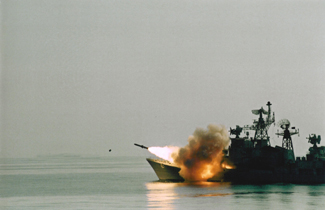 It is also being developed as a submarine-launched and air-to-air version. Both these versions are ready for initial tests and await suitable platforms. For the Indian Navy this means a suitably modified submarine which can test the missile. It is also being developed as a submarine-launched and air-to-air version. Both these versions are ready for initial tests and await suitable platforms. For the Indian Navy this means a suitably modified submarine which can test the missile.
For the Indian Air Force this means a suitably modified Sukhoi-30MKI fighter. The Air Force version of the BrahMos will have reduced length and weight, employ a new booster and a cap nose. The missile is already in serial production as it has been inducted for service by the Army and the Navy. The next variant of the BrahMos (BrahMos 2) is slated to be a hypersonic version (i.e., with a speed of over Mach 5) and is undergoing extensive laboratory tests. Reports emerging in May 2008 stated that it had achieved speeds of Mach 5.26 in laboratory tests. Senior officials then said it would take another 15-20 tests, under controlled conditions, before any launches could be undertaken. As for the future, it is speculated that BrahMos-related technology will lead to the development of long-range nuclear capable cruise missiles. This will likely emerge from the Hypersonic Technology Demonstrator Vehicle (HSTDV) project which is being developed in collaboration with the Israeli Aerospace Industries (IAI). Nirbhay (Fearless)
In July 2007, Indian defense scientists announced the proposed development of a new cruise missile system, the Nirbhay. This is designed to be a 1,000 kg/1,000 km-medium range, high sub-sonic (0.7 mach), multi-platform cruise missile that can be launched from ground, sea and air. A technology demonstrator is scheduled to be completed in early 2009. Six metres in length, the missile will be 520 mm in diameter. With its terrain-hugging capability, the missile would be able to avoid detection from ground radar. Senior scientists have said they may seek partnerships for the engine. Nag (King Cobra)
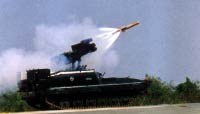 Part of the IGMDP, the Nag is an all weather, third generation, fire and forget, top attack, guided anti-tank missile, with a range of 4-7 km. The missile uses an 8 kg tandem HEAT warhead that can penetrate modern armour, including ERA (Explosive Reactive Armour) and composite armour. Part of the IGMDP, the Nag is an all weather, third generation, fire and forget, top attack, guided anti-tank missile, with a range of 4-7 km. The missile uses an 8 kg tandem HEAT warhead that can penetrate modern armour, including ERA (Explosive Reactive Armour) and composite armour. Nag uses Imaging Infra-Red (IIR) guidance with day and night capability. Mode of launch for the IIR seeker is LOBL (Lock on before launch). The missile has a complete fiberglass structure and weighs around 42 kg. Separate versions for the Army and the Air Force are being developed. The Army version can be mounted on an infantry vehicle, which will be equipped with a thermal imager for target acquisition. For the Air Force, a nose-mounted thermal imaging system has been developed. A helicopter launched version will also be available with HAL's Dhruv as the platform. According to reports, other versions of the missile may make use of an all-weather millimetric wave (MMW) seeker as an additional option. Reportedly another air-launched version, with longer range, is under development. It will be structurally different from the Nag. Induction into the army is expected to take place by November-December of 2008. Astra BVRAAM (Weapon)
The Astra is an active, radar-homing Beyond Visual Range Air to Air Missile (BVRAAM), which will become the first air-to-air missile to be developed by India once tested successfully. Such advanced missiles enable fighter pilots to lock-on and shoot down enemy aircraft 90-120 km away. Astra uses an in-house developed solid fuel propellant, though it is likely that it may be equipped with a rocket/ramjet propulsion system similar to that used in the Akash surface to air missile project. The missile has been tested periodically from 2003 onwards. It is slated to undergo a full test flight anytime in the period Aug-September 2008. Its most recent test has seen it being tested in a vertical launch mode suggesting the missile could also be deployed in an alternative, long range, surface to air mode for the Navy and the Air Force. The missile's onboard radio-frequency seeker has been designed indigenously and will have an active homing range of 15 km. The missile has a pre-fragmented warhead and is fitted with a proximity fuse. A radar fuse already exists for the Astra, but the DRDO is currently working on a new laser fuse. The range of the Astra is 80 km in head-on chase and 15 km in tail chase, with the range being extended to 100km eventually. According to DRDO scientists, the missile will intercept the targets at mach 1.2-1.4 speed. It has already been tested on the ground to prove its avionics, guidance and other sub-systems including propulsion. Astra will weigh 150 kg, making it the lightest in its class. The US deploys a similar missile which is heavier. An Israeli version is available, though with a shorter range. Akash (Sky)
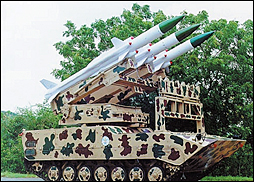 The Akash is a surface-to-air missile with an intercept range of 30 km. It has a launch weight of 720 kg, a diameter of 35 cm and a length of 5.78 metres. The missile can reach a speed of around Mach 2.5 and an altitude of 18 km. The Akash is a surface-to-air missile with an intercept range of 30 km. It has a launch weight of 720 kg, a diameter of 35 cm and a length of 5.78 metres. The missile can reach a speed of around Mach 2.5 and an altitude of 18 km. An on-board guidance system, coupled with actuator systems, makes the missile maneuverable up to 15g loads and a tail chase capability for end-game engagement. A digital proximity fuse is coupled with a 55kg pre-fragmented warhead, while the safety arming and detonation mechanism enables a controlled detonation sequence. A self-destruct device is also integrated. It is propelled by Integrated Ramjet Rocket Engine. The use of ramjet propulsion system enables sustained speeds without deceleration throughout its flight. The missile has command guidance throughout its entire flight. The Akash carries an onboard radio-proximity fuse.
Hypersonic Technology Demonstrator Vehicle (HSTDV)/ Avatar (Rebirth)
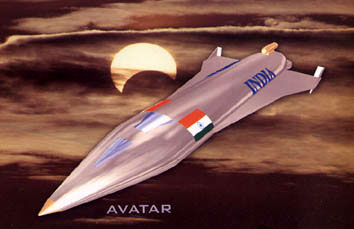 An eight-meter technology demonstrator is being built by the Defense Research & Development Laboratory (DRDL) in Hyderabad and is due to be tested sometime in the coming months. The demonstrator vehicle, being developed in cooperation with Israeli Aerospace Industries (IAI), will be powered by a "Scramjet" engine that takes in oxygen from the atmosphere and burns liquid hydrogen. An eight-meter technology demonstrator is being built by the Defense Research & Development Laboratory (DRDL) in Hyderabad and is due to be tested sometime in the coming months. The demonstrator vehicle, being developed in cooperation with Israeli Aerospace Industries (IAI), will be powered by a "Scramjet" engine that takes in oxygen from the atmosphere and burns liquid hydrogen. The hypersonic prototype will apparently be a precursor to DRDO's Aerobic Vehicle for Hypersonic Aerospace Transportation (AVATAR). According to senior DRDO officials, the primary function of the vehicle is to act as a "reusable missile launcher, one which can launch missiles, land ... and be loaded again for more missions." The proposed AVATAR will be able to take off and land like an aircraft and will also be capable of placing a payload of 1,000kg in low-earth orbit. AVATAR would take off horizontally like conventional airplanes from conventional airstrips using turbo-ramjet engines that burn air and hydrogen. Once at a cruising altitude, the vehicle would use scramjet propulsion to accelerate from Mach 4 to Mach 8. In this hypersonic cruise phase, an on-board system will collect air from which liquid oxygen will be separated. The liquid oxygen collected then would be used in the final flight phase, when the rocket engine burns the collected liquid oxygen and the carried hydrogen to attain orbit. 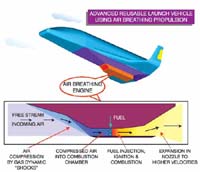 The vehicle will be designed to permit at least a hundred re-entries into the atmosphere. The vehicle will be designed to permit at least a hundred re-entries into the atmosphere.
The non-military version, a Re-usable Launch Vehicle (RLV), is similar in concept and has the Indian Space Research Organisation as the lead development agency. Previous
|